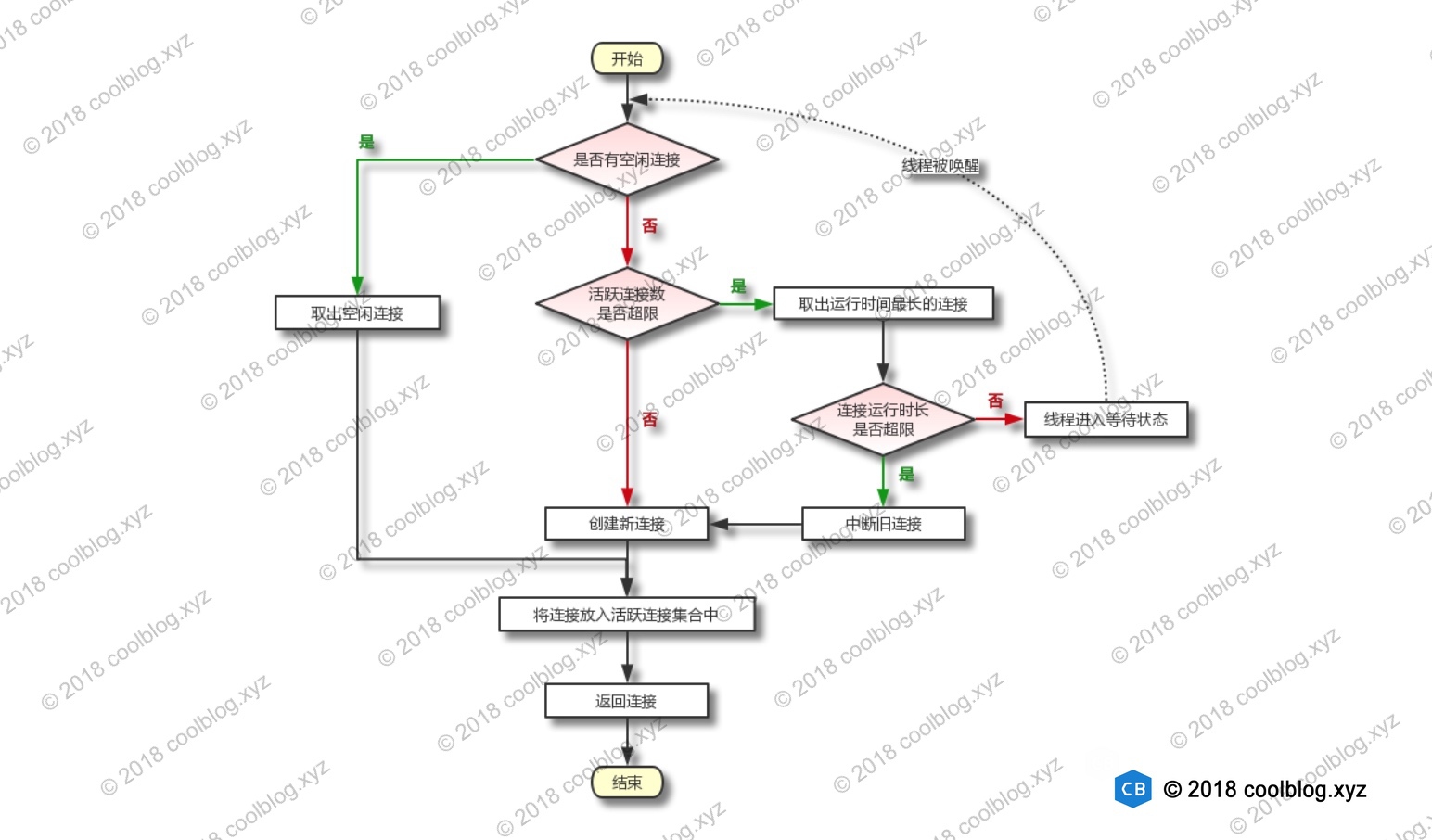MyBatis 源码分析 - 内置数据源
1.简介
本篇文章将向大家介绍 MyBatis 内置数据源的实现逻辑。搞懂这些数据源的实现,可使大家对数据源有更深入的认识。同时在配置这些数据源时,也会更清楚每种属性的意义和用途。因此,如果大家想知其然,也知其所以然。那么接下来就让我们一起去探索 MyBatis 内置数据源的源码吧。
MyBatis 支持三种数据源配置,分别为 UNPOOLED、POOLED 和 JNDI。并提供了两种数据源实现,分别是 UnpooledDataSource 和 PooledDataSource。在三种数据源配置中,UNPOOLED 和 POOLED 是我们最常用的两种配置。至于 JNDI,MyBatis 提供这种数据源的目的是为了让其能够运行在 EJB 或应用服务器等容器中,这一点官方文档中有所说明。由于 JNDI 数据源在日常开发中使用甚少,因此,本篇文章不打算分析 JNDI 数据源相关实现。大家若有兴趣,可自行分析。接下来,本文将重点分析 UNPOOLED 和 POOLED 两种数据源。其他的就不多说了,进入正题吧。
2.内置数据源初始化过程
在详细分析 UnpooledDataSource 和 PooledDataSource 两种数据源实现之前,我们先来了解一下数据源的配置与初始化过程。现在看数据源是如何配置的,如下:
1
2
3
4
5
6
| <dataSource type="UNPOOLED|POOLED">
<property name="driver" value="com.mysql.cj.jdbc.Driver"/>
<property name="url" value="jdbc:mysql..."/>
<property name="username" value="root"/>
<property name="password" value="1234"/>
</dataSource>
|
数据源的配置是内嵌在 节点中的,MyBatis 在解析 节点时,会一并解析数据源的配置。MyBatis 会根据具体的配置信息,为不同的数据源创建相应工厂类,通过工厂类即可创建数据源实例。关于数据源配置的解析以及数据源工厂类的创建过程,我在 MyBatis 配置文件解析过程一文中分析过,这里就不赘述了。下面我们来看一下数据源工厂类的实现逻辑。
1
2
3
4
5
6
7
8
9
10
11
12
13
14
15
16
17
18
19
20
21
22
23
24
25
26
27
28
29
30
31
32
33
34
35
36
37
38
39
40
41
42
43
44
45
46
47
48
49
50
51
52
53
54
55
56
57
58
59
60
61
| public class UnpooledDataSourceFactory implements DataSourceFactory {
private static final String DRIVER_PROPERTY_PREFIX = "driver.";
private static final int DRIVER_PROPERTY_PREFIX_LENGTH = DRIVER_PROPERTY_PREFIX.length();
protected DataSource dataSource;
public UnpooledDataSourceFactory() {
this.dataSource = new UnpooledDataSource();
}
@Override
public void setProperties(Properties properties) {
Properties driverProperties = new Properties();
MetaObject metaDataSource = SystemMetaObject.forObject(dataSource);
for (Object key : properties.keySet()) {
String propertyName = (String) key;
if (propertyName.startsWith(DRIVER_PROPERTY_PREFIX)) {
String value = properties.getProperty(propertyName);
driverProperties.setProperty(propertyName.substring(DRIVER_PROPERTY_PREFIX_LENGTH), value);
} else if (metaDataSource.hasSetter(propertyName)) {
String value = (String) properties.get(propertyName);
Object convertedValue = convertValue(metaDataSource, propertyName, value);
metaDataSource.setValue(propertyName, convertedValue);
} else {
throw new DataSourceException("Unknown DataSource property: " + propertyName);
}
}
if (driverProperties.size() > 0) {
metaDataSource.setValue("driverProperties", driverProperties);
}
}
private Object convertValue(MetaObject metaDataSource, String propertyName, String value) {
Object convertedValue = value;
Class<?> targetType = metaDataSource.getSetterType(propertyName);
if (targetType == Integer.class || targetType == int.class) {
convertedValue = Integer.valueOf(value);
} else if (targetType == Long.class || targetType == long.class) {
convertedValue = Long.valueOf(value);
} else if (targetType == Boolean.class || targetType == boolean.class) {
convertedValue = Boolean.valueOf(value);
}
return convertedValue;
}
@Override
public DataSource getDataSource() {
return dataSource;
}
}
|
以上是 UnpooledDataSourceFactory 的源码分析,除了 setProperties 方法稍复杂一点,其他的都比较简单,就不多说了。下面看看 PooledDataSourceFactory 的源码。
1
2
3
4
5
6
7
| public class PooledDataSourceFactory extends UnpooledDataSourceFactory {
public PooledDataSourceFactory() {
this.dataSource = new PooledDataSource();
}
}
|
以上就是 PooledDataSource 类的所有源码,PooledDataSourceFactory 继承自 UnpooledDataSourceFactory,复用了父类的逻辑,因此它的实现很简单。
关于两种数据源的创建过程就先分析到这,接下来,我们去探究一下两种数据源是怎样实现的。
3.UnpooledDataSource
UnpooledDataSource,从名称上即可知道,该种数据源不具有池化特性。该种数据源每次会返回一个新的数据库连接,而非复用旧的连接。由于 UnpooledDataSource 无需提供连接池功能,因此它的实现非常简单。核心的方法有三个,分别如下:
- initializeDriver - 初始化数据库驱动
- doGetConnection - 获取数据连接
- configureConnection - 配置数据库连接
下面我将按照顺序分节对相关方法进行分析,由于 configureConnection 方法比较简单,因此我把它和 doGetConnection 放在一节中进行分析。下面先来分析 initializeDriver 方法。
3.1 初始化数据库驱动
回顾我们一开始学习使用 JDBC 访问数据库时的情景,在执行 SQL 之前,通常都是先获取数据库连接。一般步骤都是加载数据库驱动,然后通过 DriverManager 获取数据库连接。UnpooledDataSource 也是使用 JDBC 访问数据库的,因此它获取数据库连接的过程也大致如此,只不过会稍有不同。下面我们一起来看一下。
1
2
3
4
5
6
7
8
9
10
11
12
13
14
15
16
17
18
19
20
21
22
23
24
25
26
27
28
29
|
private synchronized void initializeDriver() throws SQLException {
if (!registeredDrivers.containsKey(driver)) {
Class<?> driverType;
try {
if (driverClassLoader != null) {
driverType = Class.forName(driver, true, driverClassLoader);
} else {
driverType = Resources.classForName(driver);
}
Driver driverInstance = (Driver) driverType.newInstance();
DriverManager.registerDriver(new DriverProxy(driverInstance));
registeredDrivers.put(driver, driverInstance);
} catch (Exception e) {
throw new SQLException("Error setting driver on UnpooledDataSource. Cause: " + e);
}
}
}
|
如上,initializeDriver 方法主要包含三步操作,分别如下:
- 加载驱动
- 通过反射创建驱动实例
- 注册驱动实例
这三步都是都是常规操作,比较容易理解。上面代码中出现了缓存相关的逻辑,这个是用于避免重复注册驱动。因为 initializeDriver 放阿飞并不是在 UnpooledDataSource 初始化时被调用的,而是在获取数据库连接时被调用的。因此这里需要做个检测,避免每次获取数据库连接时都重新注册驱动。这个是一个比较小的点,大家看代码时注意一下即可。下面看一下获取数据库连接的逻辑。
3.2 获取数据库连接
在使用 JDBC 时,我们都是通过 DriverManager 的接口方法获取数据库连接。本节所要分析的源码也不例外,一起看一下吧。
1
2
3
4
5
6
7
8
9
10
11
12
13
14
15
16
17
18
19
20
21
22
23
24
25
26
27
28
29
30
31
32
33
34
35
36
37
38
39
40
41
42
|
public Connection getConnection() throws SQLException {
return doGetConnection(username, password);
}
private Connection doGetConnection(String username, String password) throws SQLException {
Properties props = new Properties();
if (driverProperties != null) {
props.putAll(driverProperties);
}
if (username != null) {
props.setProperty("user", username);
}
if (password != null) {
props.setProperty("password", password);
}
return doGetConnection(props);
}
private Connection doGetConnection(Properties properties) throws SQLException {
initializeDriver();
Connection connection = DriverManager.getConnection(url, properties);
configureConnection(connection);
return connection;
}
private void configureConnection(Connection conn) throws SQLException {
if (autoCommit != null && autoCommit != conn.getAutoCommit()) {
conn.setAutoCommit(autoCommit);
}
if (defaultTransactionIsolationLevel != null) {
conn.setTransactionIsolation(defaultTransactionIsolationLevel);
}
}
|
如上,上面方法将一些配置信息放入到 Properties 对象中,然后将数据库连接和 Properties 对象传给 DriverManager 的 getConnection 方法即可获取到数据库连接。
好了,关于 UnpooledDataSource 就先说到这。下面分析一下 PooledDataSource,它的实现要复杂一些。
4.PooledDataSource
PooledDataSource 内部实现了连接池功能,用于复用数据库连接。因此,从效率上来说,PooledDataSource 要高于 UnpooledDataSource。PooledDataSource 需要借助一些辅助类帮助它完成连接池的功能,所以接下来,我们先来认识一下相关的辅助类。
4.1 辅助类介绍
PooledDataSource 需要借助两个辅助类帮其完成功能,这两个辅助类分别是 PoolState 和 PooledConnection。PoolState 用于记录连接池运行时的状态,比如连接获取次数,无效连接数量等。同时 PoolState 内部定义了两个 PooledConnection 集合,用于存储空闲连接和活跃连接。PooledConnection 内部定义了一个 Connection 类型的变量,用于指向真实的数据库连接。以及一个 Connection 的代理类,用于对部分方法调用进行拦截。至于为什么要拦截,随后将进行分析。除此之外,PooledConnection 内部也定义了一些字段,用于记录数据库连接的一些运行时状态。接下来,我们来看一下 PooledConnection 的定义。
1
2
3
4
5
6
7
8
9
10
11
12
13
14
15
16
17
18
19
20
21
22
23
24
25
26
27
28
29
30
31
32
33
34
35
36
37
38
39
| class PooledConnection implements InvocationHandler {
private static final String CLOSE = "close";
private static final Class<?>[] IFACES = new Class<?>[]{Connection.class};
private final int hashCode;
private final PooledDataSource dataSource;
private final Connection realConnection;
private final Connection proxyConnection;
private long checkoutTimestamp;
private long createdTimestamp;
private long lastUsedTimestamp;
private int connectionTypeCode;
private boolean valid;
public PooledConnection(Connection connection, PooledDataSource dataSource) {
this.hashCode = connection.hashCode();
this.realConnection = connection;
this.dataSource = dataSource;
this.createdTimestamp = System.currentTimeMillis();
this.lastUsedTimestamp = System.currentTimeMillis();
this.valid = true;
this.proxyConnection = (Connection) Proxy.newProxyInstance(Connection.class.getClassLoader(), IFACES, this);
}
@Override
public Object invoke(Object proxy, Method method, Object[] args) throws Throwable {...}
}
|
下面再来看看 PoolState 的定义。
1
2
3
4
5
6
7
8
9
10
11
12
13
14
15
16
17
18
19
20
21
22
23
24
25
| public class PoolState {
protected PooledDataSource dataSource;
protected final List<PooledConnection> idleConnections = new ArrayList<PooledConnection>();
protected final List<PooledConnection> activeConnections = new ArrayList<PooledConnection>();
protected long requestCount = 0;
protected long accumulatedRequestTime = 0;
protected long accumulatedCheckoutTime = 0;
protected long claimedOverdueConnectionCount = 0;
protected long accumulatedCheckoutTimeOfOverdueConnections = 0;
protected long accumulatedWaitTime = 0;
protected long hadToWaitCount = 0;
protected long badConnectionCount = 0;
}
|
上面对 PooledConnection 和 PoolState 的定义进行了一些注释,这两个类中有很多字段用来记录运行时状态。但在这些字段并非核心,因此大家知道每个字段的用途就行了。关于这两个辅助类的介绍就先到这
4.2 获取连接
前面已经说过,PooledDataSource 会将用过的连接进行回收,以便可以复用连接。因此从 PooledDataSource 获取连接时,如果空闲链接列表里有连接时,可直接取用。那如果没有空闲连接怎么办呢?此时有两种解决办法,要么创建新连接,要么等待其他连接完成任务。具体怎么做,需视情况而定。下面我们深入到源码中一探究竟。
1
2
3
4
5
6
7
8
9
10
11
12
13
14
15
16
17
18
19
20
21
22
23
24
25
26
27
28
29
30
31
32
33
34
35
36
37
38
39
40
41
42
43
44
45
46
47
48
49
50
51
52
53
54
55
56
57
58
59
60
61
62
63
64
65
66
67
68
69
70
71
72
73
74
75
76
77
78
79
80
81
82
83
84
85
86
87
88
89
90
91
92
93
94
95
96
97
98
99
100
101
102
103
104
105
106
107
108
109
110
111
112
113
114
115
116
117
118
119
120
| public Connection getConnection() throws SQLException {
return popConnection(dataSource.getUsername(), dataSource.getPassword()).getProxyConnection();
}
private PooledConnection popConnection(String username, String password) throws SQLException {
boolean countedWait = false;
PooledConnection conn = null;
long t = System.currentTimeMillis();
int localBadConnectionCount = 0;
while (conn == null) {
synchronized (state) {
if (!state.idleConnections.isEmpty()) {
conn = state.idleConnections.remove(0);
} else {
if (state.activeConnections.size() < poolMaximumActiveConnections) {
conn = new PooledConnection(dataSource.getConnection(), this);
} else {
PooledConnection oldestActiveConnection = state.activeConnections.get(0);
long longestCheckoutTime = oldestActiveConnection.getCheckoutTime();
if (longestCheckoutTime > poolMaximumCheckoutTime) {
state.claimedOverdueConnectionCount++;
state.accumulatedCheckoutTimeOfOverdueConnections += longestCheckoutTime;
state.accumulatedCheckoutTime += longestCheckoutTime;
state.activeConnections.remove(oldestActiveConnection);
if (!oldestActiveConnection.getRealConnection().getAutoCommit()) {
try {
oldestActiveConnection.getRealConnection().rollback();
} catch (SQLException e) {...}
}
conn = new PooledConnection(oldestActiveConnection.getRealConnection(), this);
conn.setCreatedTimestamp(oldestActiveConnection.getCreatedTimestamp());
conn.setLastUsedTimestamp(oldestActiveConnection.getLastUsedTimestamp());
oldestActiveConnection.invalidate();
} else {
try {
if (!countedWait) {
state.hadToWaitCount++;
countedWait = true;
}
long wt = System.currentTimeMillis();
state.wait(poolTimeToWait);
state.accumulatedWaitTime += System.currentTimeMillis() - wt;
} catch (InterruptedException e) {
break;
}
}
}
}
if (conn != null) {
if (conn.isValid()) {
if (!conn.getRealConnection().getAutoCommit()) {
conn.getRealConnection().rollback();
}
conn.setConnectionTypeCode(assembleConnectionTypeCode(dataSource.getUrl(), username, password));
conn.setCheckoutTimestamp(System.currentTimeMillis());
conn.setLastUsedTimestamp(System.currentTimeMillis());
state.activeConnections.add(conn);
state.requestCount++;
state.accumulatedRequestTime += System.currentTimeMillis() - t;
} else {
state.badConnectionCount++;
localBadConnectionCount++;
conn = null;
if (localBadConnectionCount > (poolMaximumIdleConnections
+ poolMaximumLocalBadConnectionTolerance)) {
throw new SQLException(...);
}
}
}
}
}
if (conn == null) {
throw new SQLException(...);
}
return conn;
}
|
上面代码冗长,过程比较复杂,下面把代码逻辑梳理一下。从连接池中获取连接首先会遇到两种情况:
- 连接池中有空闲连接
- 连接池中无空闲连接
对于第一种情况,处理措施就很简单了,把连接取出返回即可。对于第二种情况,则要进行细分,会有如下的情况。
- 活跃连接数没有超出最大活跃连接数
- 活跃连接数超出最大活跃连接数
对于上面两种情况,第一种情况比较好处理,直接创建新的连接即可。至于第二种情况,需要再次进行细分。
- 活跃连接的运行时间超出限制,即超时了
- 活跃连接未超时
对于第一种情况,我们直接将超时连接强行中断,并进行回滚,然后复用部分字段重新创建 PooledConnection 即可。对于第二种情况,目前没有更好的处理方式了,只能等待了。下面用一段伪代码演示各种情况及相应的处理措施,如下:
1
2
3
4
5
6
7
8
9
10
11
12
13
14
15
16
17
18
19
20
21
| if (连接池中有空闲连接) {
1. 将连接从空闲连接集合中移除
} else {
if (活跃连接数未超出限制) {
1. 创建新连接
} else {
1. 从活跃连接集合中取出第一个元素
2. 获取连接运行时长
if (连接超时) {
1. 将连接从活跃集合中移除
2. 复用原连接的成员变量,并创建新的 PooledConnection 对象
} else {
1. 线程进入等待状态
2. 线程被唤醒后,重新执行以上逻辑
}
}
}
1. 将连接添加到活跃连接集合中
2. 返回连接
|
最后用一个流程图大致描绘 popConnection 的逻辑,如下:

4.3 回收连接
相比于获取连接,回收连接的逻辑要简单的多。回收连接成功与否只取决于空闲连接集合的状态,所需处理情况很少,因此比较简单。下面看一下相关的逻辑。
1
2
3
4
5
6
7
8
9
10
11
12
13
14
15
16
17
18
19
20
21
22
23
24
25
26
27
28
29
30
31
32
33
34
35
36
37
38
39
40
41
42
43
44
| protected void pushConnection(PooledConnection conn) throws SQLException {
synchronized (state) {
state.activeConnections.remove(conn);
if (conn.isValid()) {
if (state.idleConnections.size() < poolMaximumIdleConnections
&& conn.getConnectionTypeCode() == expectedConnectionTypeCode) {
state.accumulatedCheckoutTime += conn.getCheckoutTime();
if (!conn.getRealConnection().getAutoCommit()) {
conn.getRealConnection().rollback();
}
PooledConnection newConn = new PooledConnection(conn.getRealConnection(), this);
state.idleConnections.add(newConn);
newConn.setCreatedTimestamp(conn.getCreatedTimestamp());
newConn.setLastUsedTimestamp(conn.getLastUsedTimestamp());
conn.invalidate();
state.notifyAll();
} else {
state.accumulatedCheckoutTime += conn.getCheckoutTime();
if (!conn.getRealConnection().getAutoCommit()) {
conn.getRealConnection().rollback();
}
conn.getRealConnection().close();
conn.invalidate();
}
} else {
state.badConnectionCount++;
}
}
}
|
上面代码首先将连接从活跃连接集合中移除,然后再根据空闲集合是否有空闲空间进行后续处理。如果空闲集合未满,此时复用原连接的字段信息创建新的连接,并将其放入空闲集合中即可。若空闲集合已满,此时无需回收连接,直接关闭即可。pushConnection 方法的逻辑并不复杂,就不多说了。
我们知道获取连接的方法 popConnection 是由 getConnection 方法调用的,那回收连接的方法 pushConnection 是由谁调用的呢?答案是 PooledConnection 中的代理逻辑。相关代码如下:
1
2
3
4
5
6
7
8
9
10
11
12
13
14
15
16
17
18
19
20
21
|
public Object invoke(Object proxy, Method method, Object[] args) throws Throwable {
String methodName = method.getName();
if (CLOSE.hashCode() == methodName.hashCode() && CLOSE.equals(methodName)) {
dataSource.pushConnection(this);
return null;
} else {
try {
if (!Object.class.equals(method.getDeclaringClass())) {
checkConnection();
}
return method.invoke(realConnection, args);
} catch (Throwable t) {
throw ExceptionUtil.unwrapThrowable(t);
}
}
}
|
在上一节中,getConnection 方法返回的是 Connection 代理对象,不知道大家有没有注意到。代理对象中的方法被调用时,会被上面的代理逻辑所拦截。如果代理对象的 close 方法被调用,MyBatis 并不会直接调用真实连接的 close 方法关闭连接,而是调用 pushConnection 方法回收连接。同时会唤醒处于睡眠中的线程,使其恢复运行。整个过程并不复杂,就不多说了。
4.4 小节
本章分析了 PooledDataSource 的部分源码及一些辅助类的源码,除此之外,PooledDataSource 中还有部分源码没有分析,大家若有兴趣,可自行分析。好了,关于 PooledDataSource 的分析就先到这。
5.总结
本篇文章对 MyBatis 两种内置数据源进行了较为详细的分析,总的来说,这两种数据源的源码都不是很难理解。大家在阅读源码的过程中,首先应搞懂源码的主要逻辑,然后再去分析一些边边角角的逻辑。不要一开始就陷入各种细节中,容易迷失方向。
好了,到此本文就结束了。若文章有错误不妥之处,希望大家指明。最后,感谢大家阅读我的文章。
附录:MyBatis 源码分析系列文章列表
勿在浮沙筑高台















